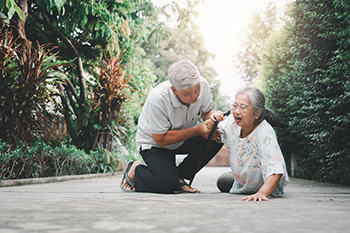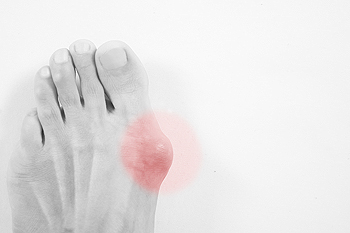Connect With Us
Blog
Items filtered by date: August 2022
Ways Seniors Can Help Prevent Falls

As a person ages, the chance of falling increases along with the repercussions. Some serious dangers that may result from a fall include a broken hip, a broken wrist, or a head injury. Since the bones are thinner and more brittle, healing can take longer. A fall may also affect a senior’s ability to live alone as well as cause chronic pain and depression. A few ways that seniors can prevent falls are by keeping the body active, having their eyes checked for vision problems, and reviewing medications for side effects. In addition, safeguarding the home by removing loose rugs, installing handrails, and improving lighting in hallways or bedrooms is recommended. Other ways to prevent falls are to install grab bars in bathrooms and use a walker or cane for balance. Wearing shoes with non-skid soles can keep you from slipping or sliding on a polished floor. Foot and ankle symptoms like numbness, tingling, and swelling can contribute to a loss of balance or stability. Please visit a podiatrist for foot and ankle strengthening exercises, as well as other information on how to protect yourself from a fall.
Preventing falls among the elderly is very important. If you are older and have fallen or fear that you are prone to falling, consult with one of our podiatrists from Florida Foot & Ankle Group, P.A.. Our doctors will assess your condition and provide you with quality advice and care.
Every 11 seconds, an elderly American is being treated in an emergency room for a fall related injury. Falls are the leading cause of head and hip injuries for those 65 and older. Due to decreases in strength, balance, senses, and lack of awareness, elderly persons are very susceptible to falling. Thankfully, there are a number of things older persons can do to prevent falls.
How to Prevent Falls
Some effective methods that older persons can do to prevent falls include:
- Enrolling in strength and balance exercise program to increase balance and strength
- Periodically having your sight and hearing checked
- Discuss any medications you have with a doctor to see if it increases the risk of falling
- Clearing the house of falling hazards and installing devices like grab bars and railings
- Utilizing a walker or cane
- Wearing shoes that provide good support and cushioning
- Talking to family members about falling and increasing awareness
Falling can be a traumatic and embarrassing experience for elderly persons; this can make them less willing to leave the house, and less willing to talk to someone about their fears of falling. Doing such things, however, will increase the likelihood of tripping or losing one’s balance. Knowing the causes of falling and how to prevent them is the best way to mitigate the risk of serious injury.
If you have any questions, please feel free to contact one of our offices located in Debary, Lake Mary, Orlando, and Oviedo, FL . We offer the newest diagnostic and treatment technologies for all your foot care needs.
Easy to Spot a Bunion

A bunion is easy to notice. It is classified as a deformity and is a bony protrusion on the side of the big toe. It can develop as a result of genetic factors or from wearing shoes that are too tight in the toe area. Research has shown it affects approximately 35% of people who are over 65 years old and may affect their quality of life if not promptly treated. The medical term for a bunion is called hallux valgus and happens when the first long bone of the foot meets the first bone of the toe. When this moves out of alignment, a bunion has formed. It often develops slowly and if it becomes severe it may shift the other toes toward each other. Flexibility and range of motion may negatively affect the foot, and the skin may become irritated. Some patients experience foot injuries, and this may lead to the development of a bunion. Additionally, existing medical conditions including flat feet and rheumatoid arthritis may increase the risk of getting a bunion. If you have noticed a bunion on your foot, it is strongly suggested that you are under the care of a podiatrist who can determine what the best course of treatment is for you, which may include surgery for permanent removal.
If you are suffering from bunion pain, contact one of our podiatrists of Florida Foot & Ankle Group, P.A.. Our doctors can provide the care you need to keep you pain-free and on your feet.
What Is a Bunion?
Bunions are painful bony bumps that usually develop on the inside of the foot at the joint of the big toe. As the deformity increases over time, it may become painful to walk and wear shoes. Women are more likely to exacerbate existing bunions since they often wear tight, narrow shoes that shift their toes together. Bunion pain can be relieved by wearing wider shoes with enough room for the toes.
Causes
- Genetics – some people inherit feet that are more prone to bunion development
- Inflammatory Conditions - rheumatoid arthritis and polio may cause bunion development
Symptoms
- Redness and inflammation
- Pain and tenderness
- Callus or corns on the bump
- Restricted motion in the big toe
In order to diagnose your bunion, your podiatrist may ask about your medical history, symptoms, and general health. Your doctor might also order an x-ray to take a closer look at your feet. Nonsurgical treatment options include orthotics, padding, icing, changes in footwear, and medication. If nonsurgical treatments don’t alleviate your bunion pain, surgery may be necessary.
If you have any questions, please feel free to contact one of our offices located in Debary, Lake Mary, Orlando, and Oviedo, FL . We offer the newest diagnostic and treatment technologies for all your foot care needs.
Blog Archives
- April 2025
- March 2025
- February 2025
- January 2025
- December 2024
- November 2024
- October 2024
- September 2024
- August 2024
- July 2024
- June 2024
- May 2024
- April 2024
- March 2024
- February 2024
- January 2024
- December 2023
- September 2023
- August 2023
- June 2023
- May 2023
- April 2023
- March 2023
- February 2023
- January 2023
- December 2022
- November 2022
- October 2022
- September 2022
- August 2022
- July 2022
- June 2022
- April 2022
- March 2022
- February 2022
- January 2022
- December 2021
- October 2021
- September 2021
- August 2021
- July 2021
- June 2021
- May 2021
- April 2021
- March 2021
- February 2021
- January 2021
- December 2020
- November 2020
- October 2020
- September 2020
- August 2020
- July 2020
- June 2020
- May 2020
- April 2020
- March 2020
- February 2020
- January 2020
- December 2019
- November 2019
- October 2019
- September 2019
- August 2019
- July 2019
- June 2019
- May 2019
- April 2019
- March 2019
- February 2019
- January 2019
- December 2018
- November 2018
- October 2018
- September 2018
- August 2018
- July 2018
- June 2018
- May 2018
- April 2018
- March 2018
- February 2018
- January 2018
